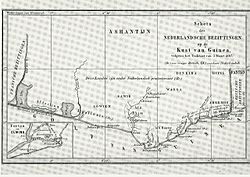| Convention between Great Britain and the Netherlands for an Interchange of Territory on the Gold Coast of Africa | |
|---|---|
 The Dutch Gold Coast after the trade of forts with Britain. The Dutch Gold Coast after the trade of forts with Britain. | |
| Signed | 5 March 1867 |
| Location | London, United Kingdom |
| Effective | 1 January 1868 |
| Parties | |
| Full text | |
The Anglo-Dutch Gold Coast Treaty of 1867 redistributed forts along the Dutch and British Gold Coasts in order to concentrate the parties' areas of influence. All forts to the east of Fort Elmina were adopted by Britain, and all forts to the west by the Netherlands.
History

Whereas the Dutch forts on the Gold Coast were a colonial backwater in the 19th century, the British forts were slowly developed into a full colony, especially after Britain took over the Danish Gold Coast in 1850. The presence of Dutch forts in an area that became increasingly influenced by the United Kingdom was deemed undesirable, and in the late 1850s British began pressing for either a buyout of the Dutch forts, or a trade of forts so as to produce more coherent areas of influence.
In the Dutch political landscape of the time, a buyout was not a possibility, so a trade of forts was negotiated. In 1867, the "Convention between Great Britain and the Netherlands for an Interchange of Territory on the Gold Coast of Africa" was signed, in which all Dutch forts to the east of Elmina were handed over to Britain, while the British forts west of Elmina were handed over to the Netherlands.
The trade proved a disaster for the Dutch, as their long-standing alliance with the Ashanti was not well received by the population around the new forts assigned to them. The people of British Komenda refused to hoist the Dutch flag and eventually resorted in taking Dutch naval officers hostage who tried to force their hand. The Dutch responded by sending a punitive expedition to Komenda in 1869–70. Meanwhile, the Fante Confederacy had laid siege to Elmina. In this context, the Dutch colonial minister secretly began negotiating a handover of all Dutch forts to Britain. With the Gold Coast Treaty of 1871, the whole colony was ceded to the United Kingdom for 46,939.62 Dutch guilders.
Tariffs
One of the principal reasons for the trade of forts was that a coherent area of influence would allow the collection of customs duties on the Gold Coast. The United Kingdom and the Netherlands committed themselves, by virtue of article 2 of the treaty, to the following tariffs on the Gold Coast:
| On the Netherland possessions | On the British possessions | |||
|---|---|---|---|---|
| Ale, beer, wine, and all spirits or spirituous liquors | per litre | eight cents | per old wine gallon | six pence |
| Cigars, snuff or tobacco in any shape | per kilogramme | ten cents | per pound | one penny |
| Gunpowder | per kilogramme | ten cents | per pound | one penny |
| Fire arms of any description | each | sixty cents | each | one shilling |
| On all goods of every other kinds | An ad valorem duty of three per cent on the invoice price | |||
Signatories
For the Netherlands:
- Arnold Adolf Bentinck van Nijenhuis [nl], Dutch envoy in London;
- Cornelis Nagtglas, ex-governor of the Dutch Gold Coast.
For the United Kingdom:
- Henry Herbert, 4th Earl of Carnarvon, Secretary of State for the Colonies;
- Edward Stanley, 15th Earl of Derby, Secretary of State for Foreign Affairs.
Forts traded
From the Netherlands to the United Kingdom
| Place in Ghana | New British name | Dutch name |
|---|---|---|
| Moree | Fort Nassau | Fort Nassau |
| Accra | Fort Ussher | Fort Crêvecoeur |
| Kormantin | Fort Cormantine | Fort Amsterdam |
| Senya Beraku | Fort Good Hope | Fort Goede Hoop |
| Apam | Fort Patience | Fort Lijdzaamheid |
From the United Kingdom to the Netherlands
| Place in Ghana | New Dutch name | British name |
|---|---|---|
| Beyin | Fort Willem III | Fort Apollonia |
| Dixcove | Fort Metalen Kruis | Fort Dixcove |
| Komenda | Fort Komenda | Fort Komenda |
| Sekondi | Fort Sekondi | Fort Sekondi |
See also
- Anglo-Dutch Treaty of 1814
- Anglo-Dutch Treaty of 1824
- Anglo-Dutch Treaties of 1870–71
- Netherlands–United Kingdom relations
Notes
- ^ Foreign & Commonwealth Office - Convention between Great Britain and the Netherlands for an Interchange of Territory on the Gold Coast of Africa
- Van Dantzig 1963, p. 94.
- Van der Ham 2013, pp. 163–166.
- Adhin 1961, p. 10.
References
- Adhin, J. H. (1961). "De immigratie van Hindostanen en de afstand van de Goudkust". Nieuwe West-Indische Gids. 41 (1): 4–13. doi:10.1163/22134360-90002334.
- Coombs, Douglas (1963). The Gold Coast, Britain, and the Netherlands, 1850–1874. Oxford: Oxford University Press.
- Van der Ham, Gijs (2013). Dof Goud. Nederland en Ghana, 1593–1872. Amsterdam & Nijmegen: Rijksmuseum Amsterdam & Uitgeverij Vanthilt. ISBN 978-94-6004-157-0.
- Van Dantzig, Albert (1963). "Le traité d'échange de territoires sur la Côte de l'Or entre la Grande-Bretagne et les Pays-Bas en 1867". Cahiers d'études africaines. 4 (13). Paris: Éditions de l’EHESS: 69–96. doi:10.3406/cea.1963.3006.